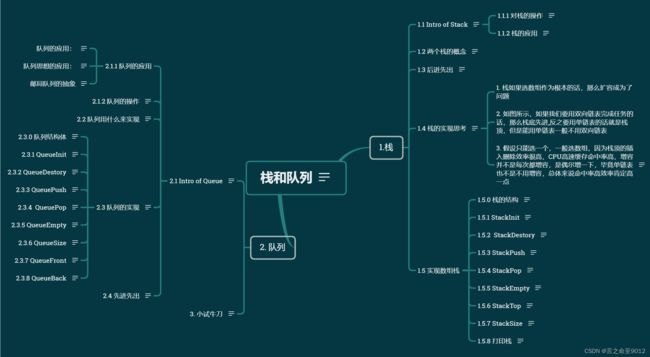请回答数据结构【栈和队列】
请回答数据结构【栈和队列】
-
- 1.栈
-
- 1.1 Intro of Stack
-
- 1.1.1 对栈的操作
- 1.1.2 栈的应用
- 1.2 两个栈的概念
- 1.3 后进先出
- 1.4 栈的实现思考
- 1.5 实现数组栈
-
- 1.5.0 栈的结构
- 1.5.1 StackInit
- 1.5.2 StackDestory
- 1.5.3 StackPush
- 1.5.4 StackPop
- 1.5.5 StackEmpty
- 1.5.6 StackTop
- 1.5.7 StackSize
- 1.5.8 打印栈
- 2. 队列
-
- 2.1 Intro of Queue
-
-
- 2.1.1 队列的应用
-
- 队列的应用:
- 队列思想的应用:
- 邮局队列的抽象
- 2.1.2 队列的操作
- 2.2 队列用什么来实现
- 2.3 队列的实现
-
- 2.3.0 队列结构体
- 2.3.1 QueueInit
- 2.3.2 QueueDestory
- 2.3.3 QueuePush
- 2.3.4 QueuePop
- 2.3.5 QueueEmpty
- 2.3.6 QueueSize
- 2.3.7 QueueFront
- 2.3.8 QueueBack
- 2.4 先进先出
-
- 3. 小试牛刀
1.栈
1.1 Intro of Stack
栈:一种特殊的线性表,其只允许在固定的一端进行插入和删除元素操作。**进行数据插入和删除操作的一端称为栈顶,另一端称为栈底。**栈中的数据元素遵守后进先出LIFO(Last In First Out)的原则。
1.1.1 对栈的操作
压栈:栈的插入操作叫做进栈/压栈/入栈,入数据在栈顶。
出栈:栈的删除操作叫做出栈。出数据也在栈顶。
每存入一个数据,栈顶(top)就往上移动一位
[外链图片转存失败,源站可能有防盗链机制,建议将图片保存下来直接上传(img-hmTIXExV-1648773291272)(C:\Users\Allen\AppData\Roaming\Typora\typora-user-images\image-20211116115052016.png)]
1.1.2 栈的应用
解决括号匹配问题,逆波兰表达式求解等等,递归改非递归
1.2 两个栈的概念
我们知道了数据结构中的栈,我们也知道操作系统中,虚拟进程地址空间的栈,是内存划分中的一个区域,这两个是一样概念的吗?
当然不是,一个是数据结构一个是用来函数调用时候建立栈帧的,只不过行为类似,是后进先出
1.3 后进先出
对于后进先出的解释,我们有一些练习题
B
C
1.4 栈的实现思考
栈是一种特殊的线性表,可以选择一下三种的任意一种实现方法都可以
- 栈如果选数组作为根本的话,那么扩容成为了问题
- 如图所示,如果我们要用双向链表完成任务的话,那么栈底先进,反之要用单链表的话就是栈顶,但是能用单链表一般不用双向链表
- 假设只能选一个,一般选数组,因为栈顶的插入删除效率很高,CPU高速缓存命中率高,增容并不是每次都增容,是偶尔增一下,毕竟单链表也不是不用增容,总体来说命中率高效率肯定高一点
一般情况下栈总归不要求是要遍历的,不然为什么不用顺序表结构呢
1.5 实现数组栈
1.5.0 栈的结构
我们可以用三个变量来定义一个栈的结构,注意容量和栈顶位置的区别
typedef int STDataType;
typedef struct Stack
{
STDataType* a;
int top; // 栈顶的位置
int capacity; // 容量
}ST;
1.5.1 StackInit
初始化一个栈
void StackInit(ST* ps)
{
assert(ps);
ps->a = NULL;
ps->top = 0;
ps->capacity = 0;
}
1.5.2 StackDestory
销毁栈
void StackDestory(ST* ps)
{
assert(ps);
free(ps->a);
ps->a = NULL;
ps->capacity = ps->top = 0;
}
1.5.3 StackPush
栈数据的插入,由于扩容只会用到一次,所以说其实不哟个单拎出来,直接写在push中就可以了
void StackPush(ST* ps, STDataType x)
{
assert(ps);
if (ps->top == ps->capacity)
{
int newCapacity = ps->capacity == 0 ? 4 : ps->capacity * 2;
ps->a = (STDataType*)realloc(ps->a, newCapacity* sizeof(STDataType));
if (ps->a == NULL)
{
printf("realloc fail\n");
exit(-1);
}
ps->capacity = newCapacity;
}
ps->a[ps->top] = x;
ps->top++;
}
1.5.4 StackPop
void StackPop(ST* ps)
{
assert(ps);
assert(ps->top > 0);
--ps->top;
}
1.5.5 StackEmpty
判空,注释掉的写法其实很多余,其实一行就可以完成
bool StackEmpty(ST* ps)
{
assert(ps);
/*if (ps->top > 0)
{
return false;
}
else
{
return true;
}*/
return ps->top == 0;
}
1.5.6 StackTop
STDataType StackTop(ST* ps)
{
assert(ps);
assert(ps->top > 0);
return ps->a[ps->top - 1];
}
1.5.7 StackSize
int StackSize(ST* ps)
{
assert(ps);
return ps->top;
}
1.5.8 打印栈
while (!StackEmpty(&st))
{
printf("%d ", StackTop(&st));
StackPop(&st);
}
printf("\n");
2. 队列
2.1 Intro of Queue
队列:只允许在一端进行插入数据操作,在另一端进行删除数据操作的特殊线性表,队列具有先进先出
FIFO(First In First Out)
2.1.1 队列的应用
队列的应用:
公平排队,广度优先遍历
队列思想的应用:
医院、营业厅,抽号机
假如有三个窗口如何保证先来先得到号呢,就是利用队列的性质,前面有多少人排队意味着队列里面含有多少数据,只不过要防止两个人同时取号,如何防止呢,就是利用操作系统当中的互斥锁来解决问题
邮局队列的抽象
下面是来自Crash Course Computer Science的对于邮局队列的抽象
2.1.2 队列的操作
入队列:进行插入操作的一端称为队尾
出队列:进行删除操作的一端称为队头
2.2 队列用什么来实现
数组不行,要满足一端入,一端出不太行
链表可以,凡是涉及到链表肯定是能用单链表就单链表,给两个指针,一边入数据,一边出数据,同时记录
尾指针和头指针
2.3 队列的实现
2.3.0 队列结构体
先封装一个Node,然后再构建队列
typedef int QDataType;
typedef struct QueueNode
{
QDataType data;
struct QueueNode* next;
}QNode;
typedef struct Queue
{
QNode* head;
QNode* tail;
//size_t size;//可以有也可以没有的变量
}Queue;
2.3.1 QueueInit
void QueueInit(Queue* pq)
{
assert(pq);
pq->head = pq->tail = NULL;
}
2.3.2 QueueDestory
void QueueDestory(Queue* pq)
{
assert(pq);
QNode* cur = pq->head;
while (cur)
{
QNode* next = cur->next;
free(cur);
cur = next;
}
pq->head = pq->tail = NULL;
}
2.3.3 QueuePush
入列
void QueuePush(Queue* pq, QDataType x)
{
assert(pq);
QNode* newnode = (QNode*)malloc(sizeof(QNode));
assert(newnode);
newnode->data = x;
newnode->next = NULL;
if (pq->tail == NULL)
{//the fist node
assert(pq->head==NULL);
pq->head = pq->tail = newnode;
}
else
{
pq->tail->next = newnode;
pq->tail = newnode;
}
}
2.3.4 QueuePop
void QueuePop(Queue* pq)
{
assert(pq);
assert(pq->head && pq->tail);
if (pq->head->next==NULL)
{// the last node
free(pq->head);
pq->head = pq->tail = nullptr;
}
else
{
QNode* next = pq->head->next;
free(pq->head);
pq->head = next;
}
}
2.3.5 QueueEmpty
bool QueueEmpty(Queue* pq)
{
assert(pq);
//return pq->head == NULL && pq->tail == NULL;
return pq->head == nullptr;
}
2.3.6 QueueSize
size_t QueueSize(Queue* pq)
{// slow or a new member variable
assert(pq);
QNode* cur = pq->head;
size_t size = 0;
while (cur)
{
size++;
cur = cur->next;
}
return size;
}
2.3.7 QueueFront
返回队首数据
QDataType QueueFront(Queue* pq)
{
assert(pq);
assert(pq->head);
return pq->head->data;
}
2.3.8 QueueBack
QDataType QueueBack(Queue* pq)
{
assert(pq);
assert(pq->tail);
return pq->tail->data;
}
2.4 先进先出
以下( )不是队列的基本运算?/
- 从队尾插入一个新元素
- 从队列中删除第i个元素
- 判断一个队列是否为空
- 读取队头元素的值
B
现有一循环队列,其队头指针为front,队尾指针为rear;循环队列长度为N。其队内有效长度为?(假设队头不存放数据)
- (rear - front + N) % N + 1
- (rear - front + N) % N
- (rear - front) % (N + 1)
- (rear - front + N) % (N - 1)
B
循环队列的存储空间为 Q(1:100) ,初始状态为 front=rear=100 。经过一系列正常的入队与退队操作后, front=rear=99 ,则循环队列中的元素个数为( )
- 1
- 2
- 99
- 0或者100
D
3. 小试牛刀
leetcode 有效括号和循环队列https://blog.csdn.net/Allen9012/article/details/121440663
leetcode 栈和队列的互相实现https://blog.csdn.net/Allen9012/article/details/121437192
注:部分图片来源于Crash Course Computer Science,如有侵权请联系我删除












